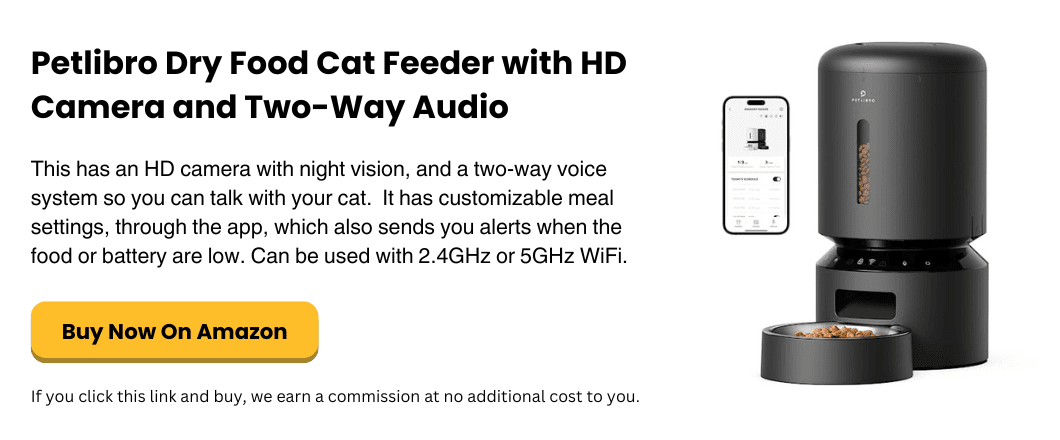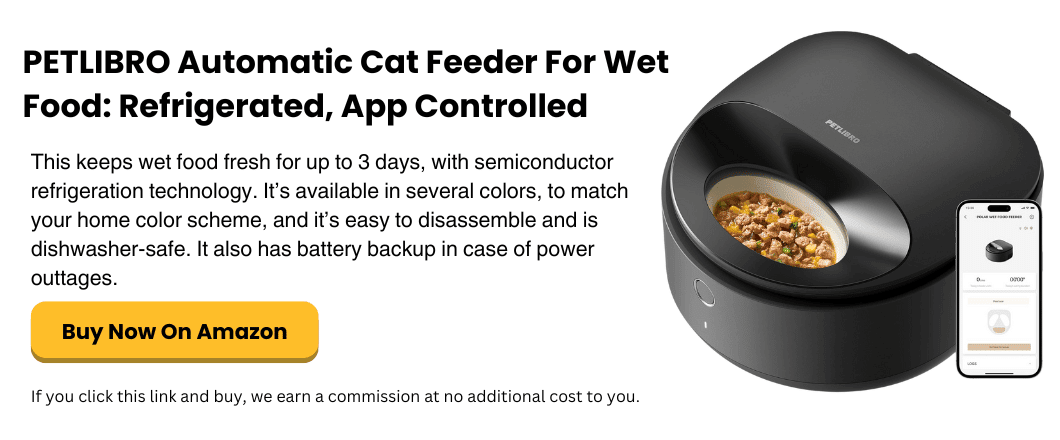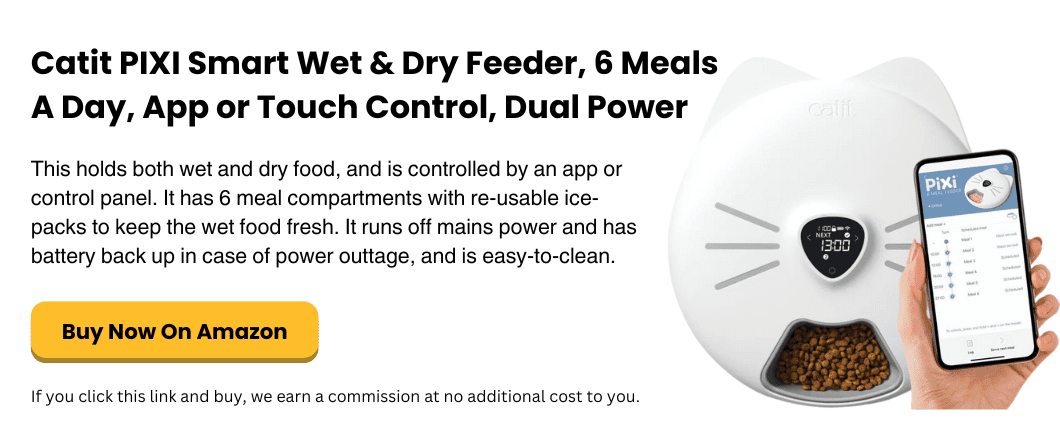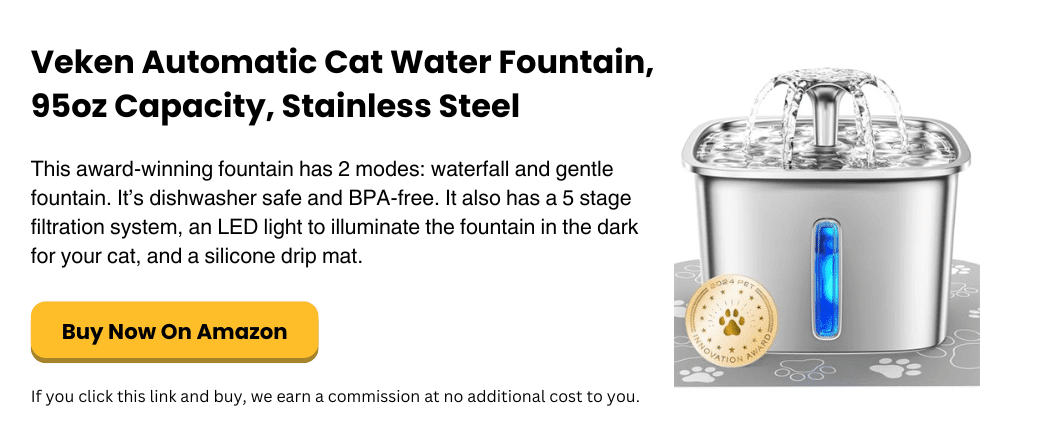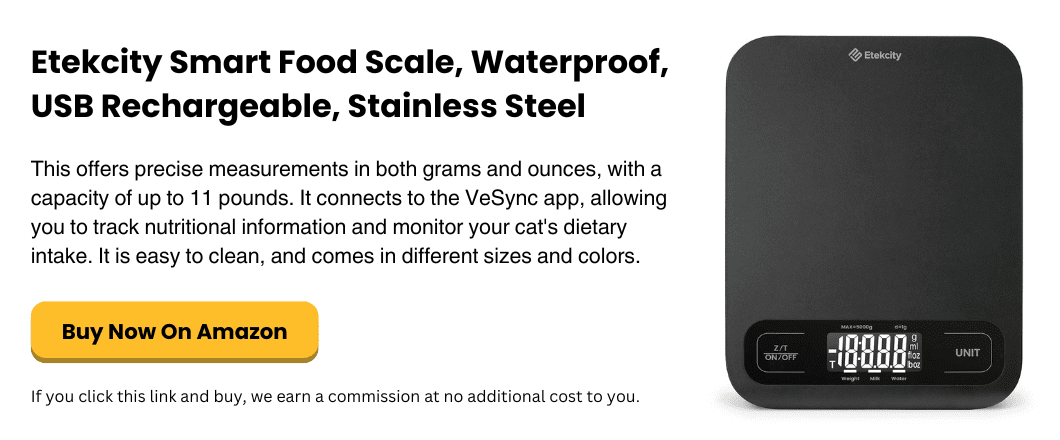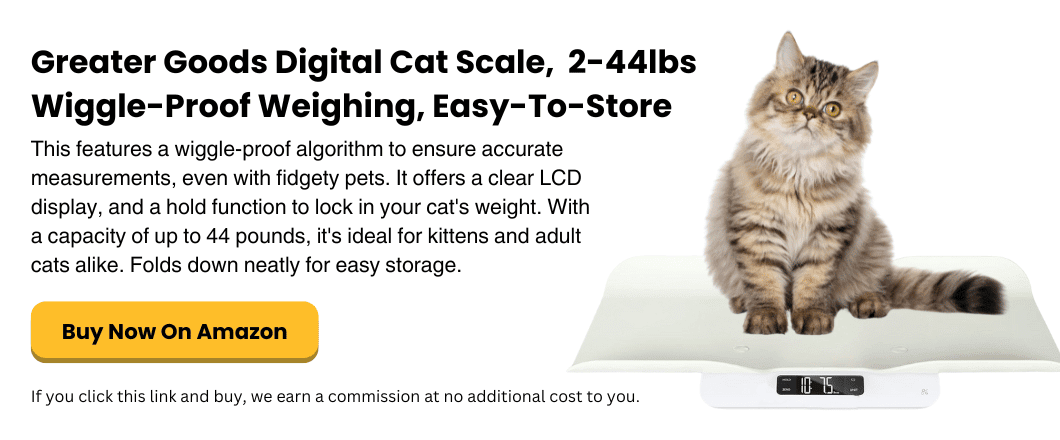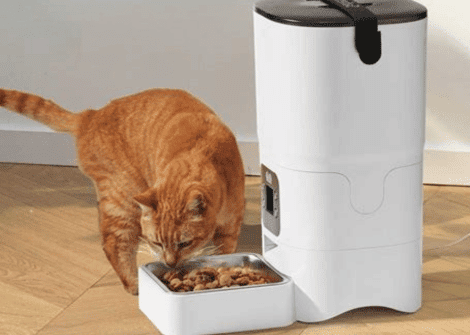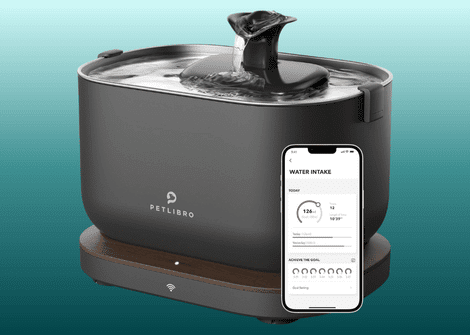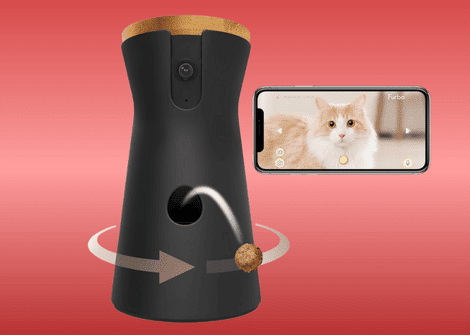How Much Should I Really Feed My Cat?
Feeding your cat the right amount of food is essential for maintaining their health, weight, and overall well-being. But with so much conflicting advice available, it can be challenging to determine how much food your cat really needs.
Factors such as age, breed, activity level, and whether your cat eats dry or wet food all play a role in deciding the appropriate portion sizes.
In this guide, we’ll break down everything you need to know about feeding your cat, including recommended portion sizes, feeding schedules, and the benefits of using smart cat feeders. Then, by the end, you’ll have a clear understanding of how to provide the best nutrition for your feline friend.
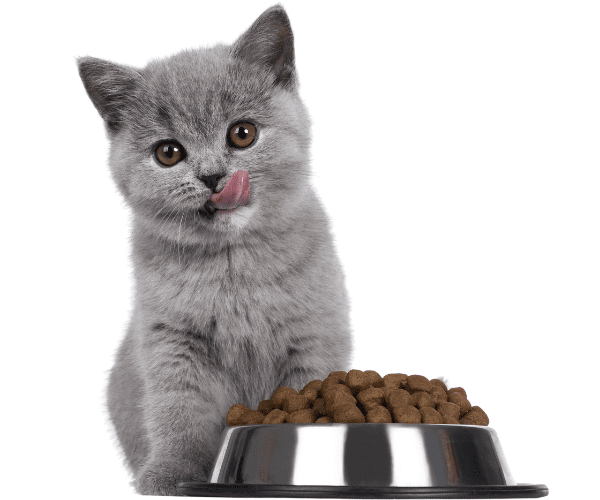
Table Of Contents
Understanding Your Cat’s Nutritional Needs
Wet Food, Dry Food – Or Both?
The Quality of Ingredients In Your Cat’s Food
How Much Dry Food Should I Feed My Cat?
How Much Wet Food Should I Feed My Cat?
How Much Mixed Food Should I Feed My Cat?
How Much Should I Feed My Kitten?
How To Use Smart Tech To Feed Your Cat Properly
Understanding Your Cat’s Nutritional Needs
Feeding your cat the right amount is important—but so is understanding what actually goes into a balanced feline diet.
Cats are obligate carnivores, which means their bodies are built to thrive on nutrients found in animal protein. While it’s easy to assume all pet food is created equal, knowing what your cat really needs can help you make better feeding choices.
Protein is the cornerstone of your cat’s diet. It provides essential amino acids like taurine, which supports heart health, vision, and digestion. Unlike some animals, cats can’t produce taurine on their own, so they need it from food—specifically, from meat-based sources.
Fats are another key nutrient. They supply energy, and they help with the absorption of fat-soluble vitamins (like A, D, E, and K). Fats also play a role in keeping your cat’s coat soft and shiny. However, cats don’t need as much of it as other animals, as too much fat can lead to weight gain, so balance is important.
Carbohydrates: cats don’t actually need a lot of carbs – in fact their digestive systems aren’t built to handle large amounts. While carbs can provide energy, excessive carbohydrate fillers in low-quality food can cause weight or blood sugar issues.
Vitamins and minerals: Beyond protein and fat, your cat also needs a variety of vitamins and minerals—including B vitamins, calcium, phosphorus, and magnesium—to support everything from bone health to metabolism.
In short, the best diet for your cat is high in animal-based protein, moderate in fat, and low in carbs, with the right mix of essential nutrients. By understanding what fuels your cat’s body, you can ensure they get the nourishment they need to live a long, healthy life.
Wet Food, Dry Food - Or Both?
When it comes to feeding your cat, the most common options are dry kibble and wet (canned) food. Each type has its benefits and drawbacks, and the best choice often depends on your cat’s individual needs, preferences, and lifestyle.
Kibble (Dry Food)
Kibble is a popular choice for many cat owners but it does have its advantages and disadvantages:
Pros:
-
Easy to store and has a long shelf life
-
Convenient to measure and serve
-
Can help reduce plaque buildup on your cat’s teeth due to its crunchy texture
-
Typically more affordable than wet food
-
Doesn’t spoil if left out during the day
Cons:
-
Lower moisture content, which may not be ideal for cats who don’t drink enough water
-
May include more fillers and carbohydrates than wet food
-
Some picky eaters may not enjoy the taste or texture
Wet Food (Canned Food)
Wet food is often favored for its high moisture content and palatability, especially for cats with dietary sensitivities or hydration needs.
Pros:
-
High moisture content supports urinary and kidney health
-
Often more appealing in smell and taste for finicky eaters
-
Typically higher in animal-based proteins
-
Great for older cats or those with dental issues
Cons:
-
More expensive than dry food
-
Needs refrigeration after opening
-
Can spoil if left out for too long
-
Messier to serve and store
Mixing Wet and Dry Food
Many cat owners choose to feed a combination of kibble and wet food to give their cats the benefits of both. This can be a flexible, balanced option—especially for cats with specific dietary or hydration needs:
Pros:
-
Provides the moisture benefits of wet food and the convenience of kibble
-
Helps prevent picky eating by offering variety in texture and flavor
-
Encourages better hydration, especially if your cat isn’t a big water drinker
-
Can help stretch your budget by balancing costlier wet food with more affordable dry food
-
Your cat will fill up quicker, which reduces overeating and weight gain
Cons:
-
Requires more planning to ensure proper portion sizes and calorie control
-
Can be messier and more time-consuming than feeding just one type
-
Some cats may start favoring wet food and ignore the dry altogether
If you choose to mix, aim to maintain a consistent feeding schedule and monitor your cat’s weight and overall health. Always consult your vet when making changes to your cat’s diet to ensure their nutritional needs are being fully met.
The Quality Of Ingredients In Your Cat's Food
When it comes to your cat’s health, what’s in their food matters just as much as how much you feed them. High-quality ingredients support everything from digestion and immunity to coat health and energy levels. Reading pet food labels can be overwhelming, but knowing what to look for—and what to avoid—can help you make informed choices that keep your cat happy and healthy.
Remember: When you look at the ingredients on the packaging or can, the ingredients are listed in order from most to least. This means that the first few ingredients make up the majority of what’s in your cat’s food.
For example, if chicken is the first ingredient, that’s a great sign—it means there’s more chicken in the food than anything else. However, if the first ingredient is corn or wheat, that means the food contains more fillers than real protein.
Key Ingredients to Look For:
-
Named animal proteins (like chicken, turkey, salmon, or beef): These are the top source of protein and amino acids your cat needs for muscle maintenance and energy.
-
Taurine: An essential amino acid for cats that supports heart health, vision, and digestion.
-
Omega-3 and Omega-6 fatty acids: Promote healthy skin and a shiny coat, and support brain and joint function.
-
Animal-based fats: Provide energy and help with the absorption of fat-soluble vitamins.
-
Vitamins and minerals: Look for a balanced blend, including B vitamins, vitamin A, calcium, and phosphorus.
-
Natural preservatives (like mixed tocopherols, a source of Vitamin E): These help maintain freshness without using harmful chemicals.
Ingredients to Avoid:
-
Meat by-products or “animal meal”: These can include various leftover parts that are lower in quality and harder to trace. They can also be roadkill!
-
Artificial colors, flavors, and preservatives: These are unnecessary for cats and can trigger allergies or digestive issues.
-
Excessive carbohydrates (like corn, wheat, or soy): Cats don’t need many carbs, and too much can lead to weight gain or blood sugar issues.
-
Sugars or sweeteners (like corn syrup): These add empty calories and may contribute to obesity and dental problems.
-
Unspecified fats (like “animal fat”): If the source isn’t named, it’s best to steer clear.
Feeding your cat high-quality food doesn’t have to be complicated—just focus on real, whole ingredients and avoid unnecessary additives. A good diet supports long-term health, and your cat will thank you for it with more energy, a healthy coat, and fewer vet visits.
How Much Dry Food Should I Feed My Cat?
Feeding your cat the right amount of dry food is key to maintaining their overall health and weight. Unlike wet food, dry kibble is more calorie-dense, so smaller portions go a long way. However, the exact amount your cat needs depends on factors like age, activity level, and current weight.
Most adult cats need around 20 calories per pound of body weight per day. Dry cat food typically contains about 300 to 400 calories per cup, depending on the brand. Always check the food label for exact calorie content, and adjust based on your cat’s needs. Overfeeding can lead to obesity, while underfeeding may cause nutritional deficiencies.
The key to feeding your cat is to know how much they weigh. It’s no good guessing, as this may lead to health issues down the line. If you’re unsure, then check out our recommended cat scale later on in this guide.
Here’s a general daily feeding guide you can use to work out exactly how much to feed your cat:
Spayed/Neutered Cats
- 0.05 cups per pound of body weight daily
Intact Cats
- 0.075 cups per pound of body weight daily
Cats Prone to Obesity
- 0.045 cups per pound of body weight daily
Cats on Weight Loss Plans
- 0.033 cups per pound of body weight daily
How to Use: Simply multiply your cat’s weight by the per-pound amount. For example:
- 10 lb spayed cat: 10 × 0.05 = 0.5 cups daily
- 10 lb intact cat: 10 × 0.075 = 0.75 cups daily
Conversion Reference:
- 1 cup = 16 tablespoons
- 1/4 cup = 4 tablespoons
- 1/3 cup ≈ 5.3 tablespoons
- 1/2 cup = 8 tablespoons
- 3/4 cup = 12 tablespoons
This per-pound approach makes it easy to calculate portions for any weight cat while maintaining the appropriate caloric intake for their specific needs.
Remember that these portions are estimates for average indoor adult cats. If your cat is particularly active, pregnant, a kitten, or a senior with health concerns, their requirements may differ. Always monitor your cat’s weight and body condition, and consult your veterinarian for personalized advice.
How Much Wet Food Should I Feed My Cat?
Wet cat food is a great way to ensure your cat stays well-hydrated while receiving high-quality animal-based protein. It’s especially helpful for cats with urinary tract concerns, those who don’t drink enough water, or picky eaters who prefer softer textures.
Wet food typically contains around 70–80% moisture and is less calorie-dense than dry food—usually between 70–100 calories per 3 oz can or pouch depending on the brand. Because of this, portion sizes may be larger, but the water content helps your cat feel full without overeating.
So here’s a general guideline for total daily wet food portions. Remember it’s best to divide this amount into two meals spread across the day.
Approximate daily portions are based on wet food averaging 85–95 calories per 3 oz can.
Spayed/Neutered Cats
-
0.5 cans per pound of body weight daily
Intact Cats
-
0.75 can per pound of body weight daily
Cats Prone to Obesity
-
0.4 cans per pound of body weight daily
Cats on Weight Loss Plans
-
0.3 cans per pound of body weight daily
How to Use: Simply multiply your cat’s weight by the per-pound amount. For example:
-
10 lb spayed cat: 10 × 0.5 = 5 cans daily
-
10 lb intact cat: 10 × 0.75 = 7.5 cans daily
Also, remember the following guidelines:
-
Transition slowly if switching from dry to wet food—mix a little wet into dry at first.
-
Always refrigerate unused portions and serve at room temperature for best results.
-
Use a kitchen scale or measuring spoon to control portions if feeding from larger cans.
-
Monitor your cat’s weight and body condition regularly and adjust portions as needed.
-
Don’t forget to offer fresh water, even with moisture-rich wet food.
How Much Mixed Food Should I Feed My Cat?
Feeding your cat a mix of wet and dry food can offer the best of both worlds—moisture from wet food to support hydration and urinary health, plus the convenience and dental benefits of kibble.
A mixed feeding approach also adds variety in flavor and texture, which can help prevent picky eating.
The key is to balance calories between both food types to avoid overfeeding. Most cats benefit from a 50/50 split in calories, but you can adjust based on preference, lifestyle, and vet recommendations.
Again, here is a general guide if you decide to give your cat a mixed feeding diet:
Spayed/Neutered Cats (Standard)
- 0.03 cups dry + 0.35 cans wet per pound daily
Intact Cats
- 0.04 cups dry + 0.45 cans wet per pound daily
Cats Prone to Obesity
- 0.02 cups dry + 0.25 cans wet per pound daily
Cats on Weight Loss Plans
- 0.02 cups dry + 0.2 cans wet per pound daily
How to Use: Multiply the figures given by your cat’s actual weight. For example:
- 10 lb spayed cat: 10 × 0.03 = 0.3 cups dry + 10 × 0.35 = 3.5 cans wet daily
Here are some pointers to keep in mind if you choose a mixed diet for your cat:
-
Serve wet food at mealtimes and leave dry food out only during the day to avoid grazing.
-
Always use a standard measuring cup or scale for accuracy.
-
Store wet food in the fridge and reheat slightly (to room temp) before serving.
-
Keep a fresh bowl of water available, even with wet food in the diet.
-
Adjust the ratio of wet to dry as needed—some cats prefer more wet food, while others enjoy kibble more.
How Much Should I Feed My Kitten?
Kittens grow fast and need a diet rich in protein, healthy fats, vitamins, and minerals to support strong development.
Feeding a mix of wet and dry food is a great way to give your kitten essential nutrients while keeping them well-hydrated. Wet food provides moisture and is easier for tiny teeth to handle, while dry food helps with dental development and adds crunch they’ll appreciate as they grow.
Because kittens have small stomachs but high energy needs, they should eat several small meals throughout the day.
Below is a general guideline for how much mixed wet and dry food to feed your kitten each day based on their age:
Based on typical calorie needs using wet food (85–100 calories per 3 oz can) and dry food (approx. 350 calories per cup).
| Kitten’s Age | Wet Food | Dry Food | Daily Feedings |
|---|---|---|---|
| 4–8 weeks | 1–1½ cans | None | 4–5 small meals/day |
| 8–12 weeks | 2–3 cans | ¼ cup | 4 meals/day |
| 3–4 months | 2 cans | ¼–⅓ cup | 3–4 meals/day |
| 4–6 months | 2–3 cans | ⅓–½ cup | 3 meals/day |
| 6–12 months | 2–3½ cans | ½–⅔ cup | 2–3 meals/day |
It’s important you choose kitten-formulated food, which has more calories and nutrients than adult food. Also, remember to use shallow bowls so your kitten can reach the food!
How to Use Smart Tech to Feed Your Cat Properly
Feeding your cat the right amount isn’t just about the food—it’s about consistency and accurate portion control. But it’s not always easy. Life gets busy, routines change, and it’s easy to forget a meal or overfill a bowl.
Smart pet products, such as automatic cat feeders, water fountains, an smart cat scales, offer helpful, tech-driven solutions to make caring for your cat more consistent, accurate, and stress-free. These products help maintain routine – even when you’re away from home – and give you peace of mind knowing your cat’s nutritional needs are being met every day.
Here are our favorite smart tools that can help you keep your cat cared for and in great health.
These are an excellent solution for busy pet owners who want to keep their cat on a regular feeding schedule. They dispense precise portions of kibble at programmed times throughout the day, helping to prevent overeating and promoting healthy weight management.
Many smart models connect to smartphone apps via Wi-Fi, giving you full control over feeding times and quantities from anywhere. They even have extra features such as voice message playback, so your cat can hear your voice when they are eating, providing comfort and reassurance – as well as peace of mind for you in these extra-busy times.
Smart wet food cat feeders are designed for cats who prefer moist meals or need a diet rich in hydration.
These advanced feeders often include built-in refrigeration or ice packs to keep wet food fresh throughout the day. With programmable meal times and portion controls, they help maintain a consistent feeding schedule, even for cats with sensitive stomachs or strict dietary needs.
Smart wet food dispensers reduce waste, improve hygiene, and offer peace of mind for owners who can’t always be home for each meal.
Smart mixed food cat feeders allow cat owners to serve both wet and dry food in one device, offering convenience and flexibility for cats on a blended diet.
These feeders are ideal for pet parents who want to balance the hydration benefits of wet food with the dental and digestive advantages of dry kibble.
With programmable meal times and separate compartments for each food type, smart mixed feeders help maintain consistency and freshness while reducing the need for multiple feeding tools. Many models also support app-based controls and feeding alerts for added convenience.
Smart cat water fountains provide a continuous flow of clean, filtered water to encourage your cat to drink more regularly.
Cats often prefer running water, and these fountains are designed to mimic that natural preference. Advanced models include app monitoring, water level alerts, and automatic shutoff features, ensuring your cat always has access to fresh water.
Promoting hydration is especially important for cats on dry food diets or with kidney or urinary issues, and smart water fountains make it easy to support your cat’s health every day.
Precision food scales are a must-have tool for cat owners who want to use traditional food bowls but also want to ensure their pet is getting the exact right amount of food.
Whether you’re feeding kibble, wet food, or a veterinary-prescribed diet, a smart food scale helps you measure out precise portions in grams or ounces. This is crucial for cats on calorie-controlled diets or those prone to obesity.
Some smart scales connect to apps that log feeding data, helping you maintain consistency and avoid over- or underfeeding. Accurate portioning supports better health outcomes and makes mealtime planning much easier.
Smart scales for weighing your cat are an essential tool for tracking changes in your cat’s health, especially when managing weight gain, loss, or chronic conditions.
These scales are designed especially for pet use, offering accurate, easy-to-read measurements and often syncing with mobile apps for ongoing tracking.
Weighing your cat regularly helps detect early signs of illness and allows you to fine-tune feeding amounts with precision. A smart scale can be especially useful for multi-cat households or kittens that need consistent monitoring as they grow.
Final Thoughts
Feeding your cat the right amount of food is one of the most important aspects of pet care. By considering factors like age, weight, activity level, and food type, you can ensure your cat stays healthy and happy.
Using tools like smart cat feeders can make portion control and scheduled feeding easier, giving you peace of mind that your cat is getting the nutrition they need. Checking their weight and regular vet visits, along with proper hydration and a balanced diet will help your feline friend live a long and healthy life.
By following these guidelines, you’ll be well-equipped to make the best feeding choices for your cat.
More Reading
It’s essential to feed your cat the right amount of food in the right number of portions. Our Guide helps you understand how to keep your cat healthy and happy.
Your cat loves to drink fresh, running water, and a Smart drinking water fountain means that they always have a constant supply of filtered, clean water.
Smart cat cameras allow you to watch, interact with, and care for your cat remotely. They connect to WiFi, and offer live video streaming, two-way audio, and even treat dispensers.

